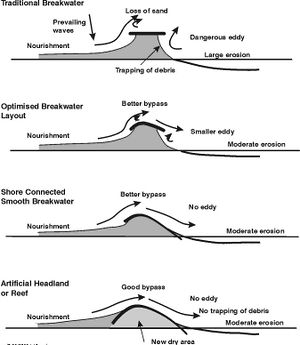Description of Breakwaters:
Breakwaters are structures constructed on coasts as part of coastal defense or to protect an anchorage from the effects of weather and longshore drift. Breakwaters are either constructed some distance from the coast or built with one end linked to it (in which case they are usually called sea walls.) They may be either fixed or floating, the choice depending on normal water depth and tidal range.
Breakwaters may also be small structures designed to protect a gently sloping beach and placed one to three hundred feet offshore in relatively shallow water
Breakwaters are subject to damage, and overtopping by big storms can lead to big problems with draining any water that gets behind them.

Locations of breakwaters: East Coast Park, Siloso Beach
Two new breakwaters have been built at Siloso Beach, on the southwest shore of Sentosa Island. They will serve to protect the beach there, as erosion has been accelerated by the wash from the high-speed ferries plying between the nearby World Trade Centre and the Riau Islands of Indonesia. At almost a kilometre in length, Siloso beach is the longest of three artificial beches built at a cost of $20 million in 1991. The new breakwaters cost more than $1 million. They are each eighty metres long and are placed about a hundred metres offshore.
Breakwaters are only needed at Siloso Beach and along the East Coast Park because elsewhere in Singapore, longshore drift is negligible.
(CREDITS: http://www.geographicasia.com/coasts/ecp1.html)


The innefectiveness of breakwaters are, firstly, it is expensive to build, each breakwaters is estimated to cost around S$1 million, hence less developed country may not be able to afford. Secondly, even though, it creates a zone of shallow water between itself and the coast, it's unable to provide complete protection due to gaps between one breakwater and the other along the coast, hence erosion may still occur.

The advantages of fixed breakwaters are that they usually consist of mounded rubble or concrete barriers. These types of breakwaters offer protection from high and fast-moving waves and can still offer protection even if mildly damaged in heavy storms. Stone or rubble that is dislocated by heavy waves can be easily repaired without having to replace the entire structure. Some aquatic creatures use breakwaters as a habitat, and fixed breakwaters that are placed with open segments allow free movement of aquatic wildlife. (CREDITS: http://www.ehow.com/list_6830350_pros-cons-breakwaters.html#ixzz200puOseE)
Here is the video link on Breakwaters in Singapore:
Thank You !


No comments:
Post a Comment